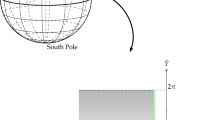Abstract
Starting from the general equations for a viscous, incompressible fluid, written in rotating spherical coordinates, an asymptotic theory for steady flow is developed. This uses only the thin-shell approximation, by suitably defining the variables and parameters. The result is a consistent theory which produces an Ekman-type balance, expressed in spherical coordinates, at leading order. The correction terms, which are mainly the nonlinear contribution in the equations, can be accommodated by invoking the method of multiple scales and using a strained coordinate. The resulting leading order, with slow/weak corrections, provides the basis for a study of oceanic gyres. By choosing the velocity (and noting the vorticity) at the surface, some examples are presented. Various choices are made, for closed particle paths expressed in a simple form (using a transformation based on the Mercator projection): zero velocity and vorticity at the centre and on the periphery of the gyre; non-zero speed on the periphery; finite-strength line vortex at the centre. In addition, in one case, we describe how the slow-z variation affects the solution. This treatment of the problem shows that our extended version of the Ekman balance, valid in spherical coordinates over large regions, can be used to investigate the properties of gyres. Many analytical and numerical options are available for future study.







Similar content being viewed by others
References
Constantin, A.: Frictional effects in wind-driven ocean currents. Geophys. Astro. Fluid Dyn. 115, 1–14 (2021). https://doi.org/10.1080/03091929.2020.1748614
Constantin, A.: Nonlinear wind-drift ocean currents in arctic regions. Geophys. Astro. Fluid Dyn. 116, 101–115 (2022). https://doi.org/10.1080/03091929.2021.1981307
Constantin, A., Johnson, R.S.: Large gyres as a shallow-water asymptotic solution of Euler’s equation in spherical coordinates. Proc. R. Soc. A 473, 2200 (2017). https://doi.org/10.1098/rspa.2017.0063
Constantin, A., Johnson, R.S.: Steady large-scale ocean flows in spherical coordinates. Oceanography 31, 42–50 (2018)
Constantin, A., Johnson, R.S.: Ekman-type solutions for shallow-water flows on a rotating sphere: a new perspective on a classical problem. Phys. Fluids 31, 021401 (2019). https://doi.org/10.1063/1.5083088
Constantin, A., Johnson, R.S.: On the modelling of large-scale atmospheric flows. J. Differ. Equ. 285, 751–798 (2021). https://doi.org/10.1016/j.jde.2021.03.019
Constantin, A., Johnson, R.S.: On the propagation of waves in the atmosphere. Proc. R. Soc. A 477, 20200424 (2021). https://doi.org/10.1098/rspa.2020.0424
Constantin, A., Johnson, R.S.: On the dynamics of the near-surface currents in the Arctic Ocean, submitted (2022)
Daners, D.: The Mercator and stereographic projections, and many in between. Am. Math. Monthly 119, 199–210 (2012). https://doi.org/10.4169/amer.math.monthly.119.03.199
Ekman, V.W.: On the influence of the Earth’s rotation on ocean-currents. Ark. Mat. Astron. Fys 2, 1–52 (1905)
Herbei, R., McKeague, I., Speer, K.G.: Gyres and jets: inversion of tracer data for ocean circulation structure. J. Phys. Oceanogr. 39, 1180–1202 (2009). https://doi.org/10.1175/2007JPO3835.1
Johnson, R.S.: An introduction to the mathematical fluid dynamics of oceanic and atmospheric flows, ESI Lecture Note series, to appear (2023)
Lewis, D.M., Belcher, S.E.: Time-dependent, coupled. Ekman boundary layer solutions incorporating Stokes drift, Dyn, Atmospheres Oceans, 37(4), 313-351 (2004). https://doi.org/10.1016/j.dynatmoce.2003.11.001
Özkömen, T.M., Chassignet, E.C.: Emergence of inertial gyres in a two-layer quasigeostrophic ocean model. J. Phys. Oceanogr. 28, 461–484 (1998). https://doi.org/10.1175/1520-0485(1998)028%3c0461:EOIGIA%3e2.0.CO;2
Paldor, N.: Shallow Water Waves on the Rotating Earth. Springer, Cham (2015)
Pedlosky, J.: On the weakly nonlinear Ekman layer: thickness and flux. J. Phys. Oceanogr. 38, 1334–1339 (2007). https://doi.org/10.1175/2007/JPO3830.1
Roberti, L.: Perturbation analysis for the surface deflection angle of Ekman-type flows with variable eddy viscosity. J. Math. Fluid Mech. 23, 1–7 (2021). https://doi.org/10.1007/s0001-021-00586-y
Samelson, R.M.: The Theory of Large-Scale Ocean Circulation. Cambridge University Press, Cambridge (2011)
Sandor, B., Szabo, K.G.: Simple vortex models and integrals of two dimensional gyres. In Proc. Second Conf. Junior Res. Civil Eng., 284-291, Budapest, Hungary (2013)
Shrira, V.I., Almelah, R.B.: Upper-ocean Ekman current dynamics: a new perspective. J. Fluid Mech. (2020). https://doi.org/10.1017/jfm.2019.1059
Wunsch, C.: Modern Observational Physical Oceanography. Princeton University Press, New Jersey (2015)
Zhong, W., Zhao, J., Shi, J., Cao, Y.: The beaufort gyre variation and its impact on the Canada Basin in 2003–2012. Acta Oceanol. Sin. 34, 19–31 (2015)
Acknowledgements
The author thanks a referee for some instructive comments and suggestions, which have enabled this work to be placed within a slightly more general framework, connecting it to other properties of Ekman-type flows.
Funding
The author is solely responsible for the ideas and material presented here; there was no direct financial support for this research, although it was initiated during a visit to the Faculty of Mathematics, Vienna University, organised and supported by Prof. Adrian Constantin.
Author information
Authors and Affiliations
Corresponding author
Additional information
Communicated by Michael Kunzinger.
Publisher's Note
Springer Nature remains neutral with regard to jurisdictional claims in published maps and institutional affiliations.
Rights and permissions
Springer Nature or its licensor (e.g. a society or other partner) holds exclusive rights to this article under a publishing agreement with the author(s) or other rightsholder(s); author self-archiving of the accepted manuscript version of this article is solely governed by the terms of such publishing agreement and applicable law.
About this article
Cite this article
Johnson, R.S. A theory for oceanic gyres based on Ekman flows using the thin-shell approximation with weak nonlinearity. Monatsh Math 202, 807–830 (2023). https://doi.org/10.1007/s00605-023-01826-1
Received:
Accepted:
Published:
Issue Date:
DOI: https://doi.org/10.1007/s00605-023-01826-1



